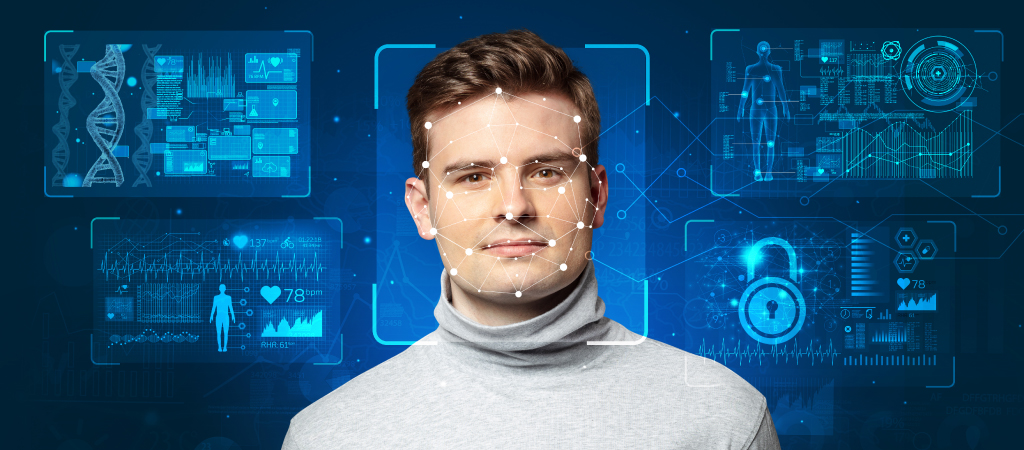How does face authentication work?
Have you ever wondered why your face is scanned at customs when you enter a country? Or how the new iPhone can unlock using your face instead of a password? The answer is facial recognition/authentication technology.
• More secure than conventional mobile phone-based facial recognition as profiles are stored on the bank’s server.
• Platform Independent: The API-based solution makes it easy to integrate
• Works in all conditions: Low lighting, day/night contrasts & more
• Works effectively even when the user is wearing any cap, spectacles, etc.
• Verification time: Less than 3-seconds
• Dual-layer Liveness Detection: Ability to detect the first layer i.e. front-end from a mobile application (platform-dependent) & the second layer i.e. back-end from server verification.
• Works with normal internet bandwidths for any requirement regarding online banking transactions.
Overall, if used correctly and proportionately, facial recognition can help safeguard the public and improve national security on several fronts. It can do a lot more to increase security in the future – from street crime to airport security, all the way through to assisting those battling addiction, technology has the potential to take operations & security to newer heights.
What is Facial Recognition?
Facial Recognition System, known as a biometric software application, is competent in distinctively recognizing or verifying an individual by comparing and examining patterns on the basis of an individual’s face-based contours. Simply put, this software can analyze your features, match them with information in a database and identify who you are.How does it work?
The general functioning of a Face Authentication System is as follows:a) Face Detection:
To start, the camera will detect and identify a face, either in isolation or in a crowd. The face is perfectly detected when an individual is looking straight at the camera. The technological advancements have enabled slight variations from this to work as well.b) Face Analysis:
Next, an image of the face is captured and evaluated. Most of the facial recognition depends on the 2D images rather than 3D ones as it can conveniently match a 2D photo better with public pictures or those in a databank. Unique landmarks or nodal points construct each face. Facial recognition software will evaluate the nodal points, for instance, the space between your eyes or the structure of your cheekbones.c) Converting an Image to Data:
The analysis of your face is then turned into a mathematical formula. These facial characteristics transform into numbers as a code. This numerical code is called a faceprint. Like the distinctive structure of a thumbprint, everyone has their own faceprint.d) Finding a Match:
Your code is then contrasted against a databank of other faceprints. This databank has images with detection that can be compared. The technology then recognizes a match for your precise features in the given database. It returns with the corresponding match and attached information such as the name and address.Sunartek’s Facial Recognition Systems
Facial Recognition systems at Sunartek, not only capitalize on a person’s facial dimensions but are also alert when the faces don’t match. Considering one’s picture as a storage for a centralized server, our Facial Recognition Systems can identify the same picture encountered across diverse cameras. With the use of biometric software and pattern analyzing skills, our Facial Recognition Systems intends to heighten security parameters for public safety and different businesses/services. We have designed and developed the fastest and accurate Facial Recognition Systems that operate cost-effectively on IP cameras, smartphones and body-worn devices, addressing two major concerns: Security and Customer Data Enrichment. Facial Recognition Systems from Sunartek ensure utmost security across the banking sector, corporate arena, governmental organizations and defense industry. In fact, when considering the banking sector, despite several security measures taken by financial institutions worldwide, banking fraud is still a recurring problem. While Banks have become sophisticated at using one-time passwords to authorize transfers or access accounts, there’s still room for improvement. One possible solution is biometric identification via facial recognition technology. Imagine! Instead of those OTPs (one-time passwords), what if you could manage transactions by looking at your PC or smartphone? Biometric online banking is another beneficial trait of face recognition, right there. This is where Sunartek’s Face Authentication for Remote Banking Services (FARBS System) can prove to be beneficial. Sunartek’s FARBS system is an ‘API-based solution’ that can be integrated with a banking application either on a mobile phone or a mobile banking web server. The API is available for Android, iOS, Windows, and Linux platforms.Beneficial features of the FARBS System:
• Hackers will not have access to the customer’s account, even if they bypass mobile security.• More secure than conventional mobile phone-based facial recognition as profiles are stored on the bank’s server.
• Platform Independent: The API-based solution makes it easy to integrate
• Works in all conditions: Low lighting, day/night contrasts & more
• Works effectively even when the user is wearing any cap, spectacles, etc.
• Verification time: Less than 3-seconds
• Dual-layer Liveness Detection: Ability to detect the first layer i.e. front-end from a mobile application (platform-dependent) & the second layer i.e. back-end from server verification.
• Works with normal internet bandwidths for any requirement regarding online banking transactions.
Overall, if used correctly and proportionately, facial recognition can help safeguard the public and improve national security on several fronts. It can do a lot more to increase security in the future – from street crime to airport security, all the way through to assisting those battling addiction, technology has the potential to take operations & security to newer heights.

